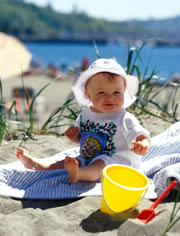Mice give skin cancer clue

Mice work says keep kids safe from the sun. <br>© Photodisc
Mouse studies emphasize children’s cancer risk from sunburn.
Serious sunburn in childhood may raise the risk of developing the deadliest form of skin cancer as an adult, research in mice suggests1. The experiments could lead to a better understanding of malignant melanoma and of how and when to protect ourselves from the sun.
“I have my kids wear hats and put sunscreen on like crazy now,” says the study’s leader Glenn Merlino, of the National Cancer Institute in Bethesda, Maryland. The differences between mice and human skin mean that caution is needed in interpreting the results, he says, but they still hold lessons for parents.
Merlino’s team has engineered mice with “the closest thing we see to human skin”, he says. Melanocytes, the pigment-producing cells that become cancerous in melanoma, are spread through the rodents’ skin as they are in humans. Normal mouse skin is quite different.
Mice given a sunburn-inducing dose of ultraviolet light at 3.5 days of age began to develop melanomas at around 6 months old. By a year of age, about half of these mice had cancer. Six-week-old mice given the same amount of ultraviolet light did not develop tumours.
The human equivalents of these mouse ages is not yet clear. The team aims to study exposure over a wider range of times to work out when young humans may be most at risk from sunburn.
The dangers of childhood sunburn are well known, says dermatologist Rona Mackie of the University of Glasgow, UK. “We’ve preached for years that young children are particularly vulnerable,” she says. The age-related association between sunburn and melanoma contrasts with other forms of skin cancer, in which the risk rises more steadily with overall exposure to the sun.
Mackie believes this mouse model may help discover how ultraviolet light leads to cancer. Sunburn could turn melanocytes cancerous directly, or it might render the immune system unable to destroy cancer cells when they appear later, she says.
Such an understanding might yield therapies for repairing sunburn damage, Mackie adds.
References
- Noonan, F. P. et al. Neonatal sunburn and melanoma in mice. Nature, 413, 271 – 272, (2001).
Media Contact
More Information:
http://www.nature.com/nsu/010920/010920-10.htmlAll latest news from the category: Health and Medicine
This subject area encompasses research and studies in the field of human medicine.
Among the wide-ranging list of topics covered here are anesthesiology, anatomy, surgery, human genetics, hygiene and environmental medicine, internal medicine, neurology, pharmacology, physiology, urology and dental medicine.
Newest articles

Superradiant atoms could push the boundaries of how precisely time can be measured
Superradiant atoms can help us measure time more precisely than ever. In a new study, researchers from the University of Copenhagen present a new method for measuring the time interval,…

Ion thermoelectric conversion devices for near room temperature
The electrode sheet of the thermoelectric device consists of ionic hydrogel, which is sandwiched between the electrodes to form, and the Prussian blue on the electrode undergoes a redox reaction…

Zap Energy achieves 37-million-degree temperatures in a compact device
New publication reports record electron temperatures for a small-scale, sheared-flow-stabilized Z-pinch fusion device. In the nine decades since humans first produced fusion reactions, only a few fusion technologies have demonstrated…





















